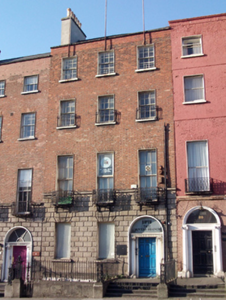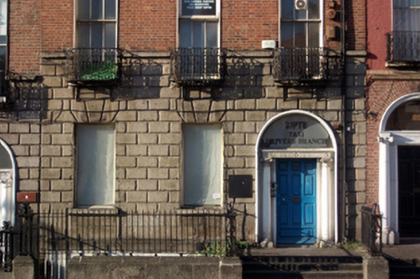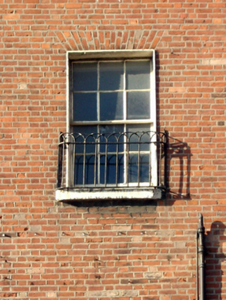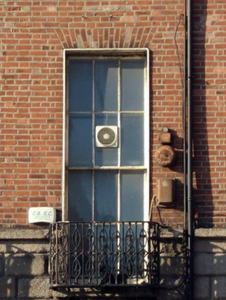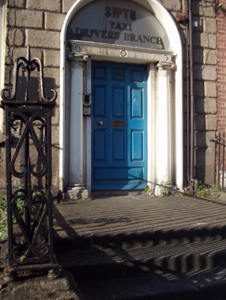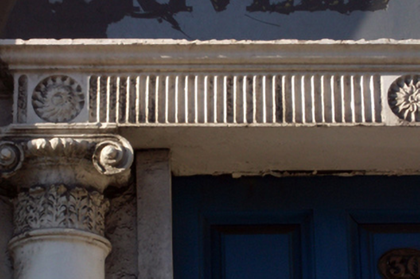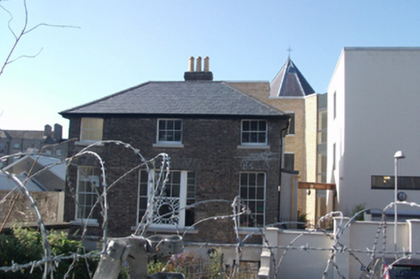Survey Data
Reg No
50010649
Rating
Regional
Categories of Special Interest
Architectural, Artistic
Original Use
House
Historical Use
Office
Date
1755 - 1765
Coordinates
315530, 235073
Date Recorded
28/09/2011
Date Updated
--/--/--
Description
Terraced three-bay four-storey house over exposed basement, built c.1760. Recently in use as offices, now disused. Later one and two-storey additions to rear. Hipped slate roof behind rebuilt parapet wall with squared granite coping. Stepped and red brick chimneystacks with clay and terracotta pots, shared with adjoining houses. Replacement uPVC rainwater goods throughout. Flemish bond red brick walls with granite string course to first floor over rusticated granite ashlar wall to ground floor. Squared granite plinth course over ruled-and-lined rendered wall to basement level. Rendered walls to rear elevation and additions. Square-headed window openings to ground floor having channelled granite voussoirs. Gauged red brick flat-arched window openings to upper floors with rendered reveals. Granite sills throughout. Six-over-six pane timber sliding sash windows to second floor and first and third bays of first floor, replacement timber sliding sash windows elsewhere, one-over-one pane to basement, middle first floor window being one-over-six pane, and six-over-six pane to top floor. Fixed plate-glass windows to ground floor. Cast-iron balconettes to first and second floors. Round-headed door opening with raised render reveal to painted stone doorcase comprising engaged Ionic columns on plinth blocks supporting fluted frieze under replacement fanlight within rendered archivolt. Replacement timber door opening onto sandstone flagged platform with cast-iron bootscrapers and three nosed granite steps to approach bridging basement. Approach flanked by wrought-iron railings with wrought and cast-iron panels inset and corner posts on replacement granite plinth. Wrought-iron gate accessing cement staircase with cast-iron handrail to basement. Three-bay two-storey over basement red brick and rendered mews to rear having hipped artificial slate roof, brick chimneystack with terracotta pots and yellow brick walls laid in Flemish bond with replacement timber sliding sash windows. Mews flanked by rendered boundary wall and backing onto Dominick Place.
Appraisal
Located on historic Parnell Square, this finely-proportioned townhouse with its pleasantly-proportioned façade is an integral component of the streetscape, and was built by Patrick Kent who leased the site in 1760. The retention of various historic features including balconettes, a fine doorcase, historic sash windows and the pleasant rustication to the ground floor provide the building with a refined and early aspect. The characteristics of Georgian architecture are evident in the fenestration pattern and the presentation of the basement area, with plinth wall and railings, and with steps to the ground floor entrance. The retention of its historic mews, though altered materially and contextually, further augments the architectural significance of this site. Parnell Square was the creation of Dr Bartholomew Mosse who, in 1748, leased four acres at the junction of three important sites: the Gardiner Estate, Sackville (now O’Connell) and Great Britain (now Parnell) Streets. There the New Gardens (now Garden of Remembrance) were constructed, a landscaped tract of land with illuminated paths, obelisks and loggia. Entrance fees to the gardens funded the construction of the Rotunda Hospital to the south, Mosse’s life ambition, and the success of the gardens precipitated the development of the surrounding square, largely by the hospital's chief builders.

